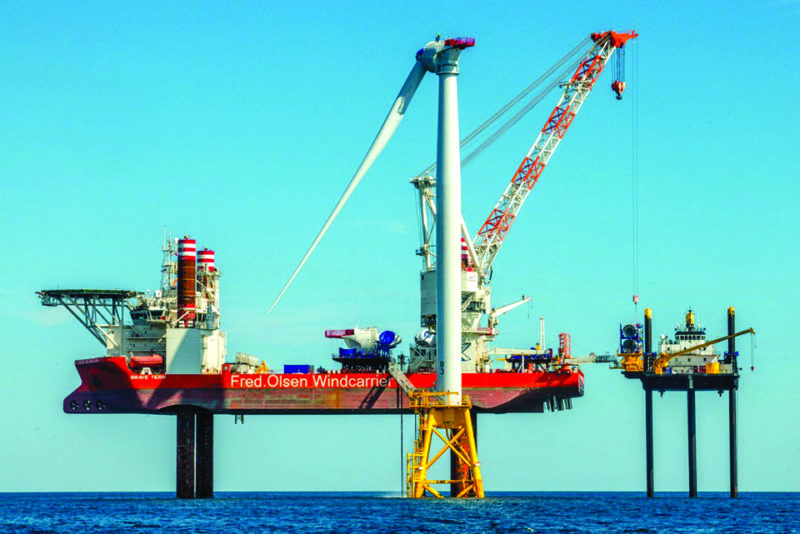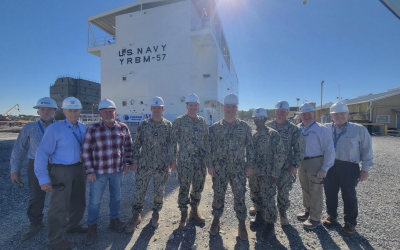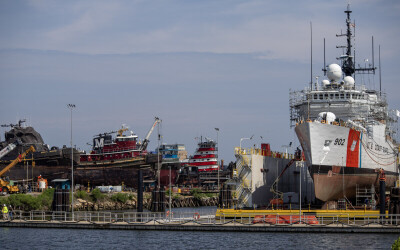Off the New Jersey coast, the bright red hull of the Fugro Enterprise has become a familiar sight to commercial fishermen who pull shellfish dredges and tend gillnets.
Plodding along at around 4 knots, the 170'x40'x11' survey vessel is making detailed geotechnical surveys for the Ocean Wind energy project, planned by Ørsted to accommodate towering wind turbines that would supply New Jersey with its first 1,100 megawatts of renewable energy generated by offshore wind.

The CTV Atlantic Pioneer has serviced the Block Island Wind Farm since spring 2016. Blount Boats photo
To New Jersey’s renewable power advocates and Democratic Gov. Phil Murphy, the work is a welcome sight. It’s the first step toward building what they hope will be 3,500 MW of offshore power by 2030.
For people in the state’s seafood industry — including the long-established and profitable scallop and surf clam fleets — the big red boat portends a new struggle to stay in business.
“The impact to New Jersey will be devastating if the commercial fishing industry is displaced at all,” warned Brick Wenzel, a captain who fishes out of Point Pleasant Beach, N.J., as state utility regulators prepared measure so Ørsted and other companies could bid for power contracts.
The U.S. Bureau of Ocean Energy Management (BOEM) and Coast Guard have put wind developers on notice that they will need to plan for wide, safe vessel traffic lanes through future turbine arrays.
But that’s just one challenge ahead for an industry, born in the waters of northern Europe that now looks to develop potentially the richest wind energy market in the world.
In U.S. waters, offshore wind developers face hurdles of finding enough heavy-lift construction vessels, and even physical space in U.S. ports to accommodate the coming generation of giant wind turbines.
LOTS OF WIND, RIGHT SPOT
The East Coast between southern New England and the Carolinas is so attractive for offshore energy development because it has consistent year-round wind close to “load centers” — Boston, New York and other cities of the eastern megapolis, said James Bennett, who heads BOEM’s renewable energy program.
The pioneer was Deepwater Wind (now part of Ørsted) with its five-turbine, 30-MW Block Island Wind Farm of Rhode Island that went online in 2016. The same year Equinor (then known as Statoil) won a 79,350-acre lease for its Empire Wind project, tucked between shipping lanes into New York Harbor.
Two years later companies bid almost double what Equinor spent per acre to secure three more leases south of Martha’s Vineyard, Mass., for $135 million each in December 2018.
“I think what you’ll see with these leases in place is tremendous acceleration down to Virginia,” said Bennett.

An offshore wind turbine under construction. Siemens photo
With that market signal, U.S. shipbuilders and other would-be suppliers have been stepping up with their offerings. Two major trade shows, the International Partnering Forum 2019 presented by the Business Network for Offshore Wind in New York City in April, and the U.S. Offshore Wind conference in Boston in June, both counted packed houses with around 1,400 attendees each.
In May Ørsted and partner WindServe Marine LLC, an affiliate of New York-based Reinauer Group, announced plans to build a pair of crew transfer vessels (CTVs). The BMT Group-designed catamarans will be the second and third U.S.-flag CTVs since Blount Boats, Warren, R.I., built the CTV Atlantic Pioneer to service the Block Island turbines.
The first is under construction at U.S. Workboats, Hubert, N.C., to be delivered for use on Ørsted’s Coastal Virginia Offshore Wind Project, a pilot project with Dominion Energy for two 6-MW turbines. Later it will work on other Ørsted projects in the Northeast, and be joined by the second vessel to be built at Reinauer’s Senesco Marine, North Kingstown, R.I.
The companies did not release many details about their design for what could soon be a very competitive market.
“The big demand for CTVs is during construction, and you will need them long before you think you will” for early stages of moving generators and other equipment as well as workers, Ian Bryan, interim managing director of CWind, a CTV builder in the United Kingdom, said at a well-attended session on vessel design at the IPF conference in New York.
“There are plenty of (U.S.) companies just waiting for you guys to place orders,” said Luther Blount III of Blount Boats, Warren R.I., which delivered the 70'6"x24'x4' Atlantic Pioneer in 2016. It takes 12 to 14 months to build such a vessel, subject to Coast Guard safety regulations and certification, Blount added. “Please don’t wait until the last second. Give us time to build the boat.”
The next generation of CTVs taking shape in Europe is trending toward more speed, air cushioned hulls and even hybrid power. CWind’s latest CTV is a 22-meter (72’) catamaran with capacity to carry 24 technicians with surface effect air cushioning.
Readied for charter in Europe in May, it has hybrid diesel and electric power, with a battery boost providing an additional 9 tons bollard push when the boat noses up to a turbine from crew boarding, said Bryan. “So it will be a leading class vessel, and a step toward a fully electric CTV.”
While U.S. builders are ready to deliver CTVs, another potential bottleneck looms for the industry: a tight global supply of heavy-lift vessels for turbine installations.
JONES ACT CONCERNS
With its Block Island project, Deepwater Wind built local political support by buying and hiring locally. Other wind developers are following that playbook, saying they plan to have vessels built near where they hold federal offshore leases.
“Choosing WindServe to build our CTVs at Senesco will provide locally built vessels and a local operator for the domestic offshore wind industry,” Thomas Brostrøm, president and CEO of Ørsted North America, said in announcing the contract.
Much less clear is when the first purpose-built, U.S.-flag construction vessel will appear. It’s a subject of much debate in the industry.
Unlike projects elsewhere, wind developers must contend with the Jones Act, which mandates that cargo moving between U.S. ports be carried on U.S.-built, -owned and -crewed vessels.
A 2017 study by Houston-based design and engineering firm GustoMS, commissioned by state energy planners in New York, Massachusetts and Rhode Island, estimated that building a self-propelled wind turbine installation vessel (WTIV) would cost $222 million delivered from a U.S. shipyard in 34 months, based on estimates provided by World Marine, Edison Chouest/Bollinger Shipyard and Conrad Industries.
At that price, the WTIV owner would need at least a decade’s worth of work, or about 3,500 to 4,000 MW of wind generators installed, according to the study.
Another option would use ‘feeder barges’ to carry turbine components and material from Northeast ports to a WTIV jacked up on site. That was the strategy employed by Deepwater Wind, using U.S. tugs and barges out of Rhode Island to supply the Brave Tern, a 433'x128' jackup operated by Norway-based Fred.Olsen Windcarrier, along with smaller U.S. liftboats that Montco Offshore sent up the East Coast from the Gulf of Mexico.
It allowed the Block Island Wind Farm project to proceed within the Jones Act requirements, while using a European WTIV because nothing comparable is yet available in the U.S. But the global supply of those vessels is limited to about a dozen now, with day rates as high as $180,000, Bloomberg reported in May.
“The day rates aren’t competitive now, and you’re paying the day rates for getting across the Atlantic,” said Anthony Logan, a senior analyst in Wood Mackenzie’s power and renewables group.

The U.S. market is preparing for more offshore wind. Ørsted photo
A U.S.-flag WTIV “should have been built a couple of years ago” to be ready for the scale of projects now planned, said Logan. Feeder barges will be the necessity for the first installations, but with both Europe and North America set for major expansion in 2023 “there’s going to be some competition and it will raise rates” for existing WTIVs, he said.
That demand will spur someone to build the first Jones Act compliant installation vessel. With U.S. projects now in the pipeline, “the annual installations by our calculation is above what they need” to finance the vessel, said Logan.
The question is what that WTIV will need in capability, he added: “It’s a rapidly evolving industry. They are building 10- and 12-megawatt turbines now … you can’t use the same vessels that were state of the art five years ago. By the end of the next decades we could be looking at 20-megawatt turbines.”
With the accelerating growth of projects worldwide, some in the industry say the tight supply combined with the Jones Act will be a roadblock for U.S. developers. “It will be a hindrance,” said Edgare Kerkwijk of the Asia Wind Energy Association.
“I cannot wait for the day that I do not have to answer a Jones Act question,” said Liz Burdock, president of the Business Network for Offshore Wind.
But Burdock foresees that the U.S. market will be big enough soon to need a U.S.-flag WTIV, “and someone will take a chance and build it.”
“I think the bigger question is how do you build a ship that keeps up with the technology?” she added.
That’s because wind turbine designers are scaling up the machines in size and generating capacity, to achieve greater efficiency in offshore arrays. The GE Haliade-X 12-MW design, planned to be available in 2021, will stand 853' over the ocean, nearly as high as New York’s Chrysler Building and the Eiffel Tower in Paris.
With a 722'-diameter rotor, GE says the turbine will turn out 45% more annual electricity production than the largest machine now on the market.
SUBSIDIES WIND DOWN
New York state’s goal of generating 9 gigawatts of offshore wind power by 2030 “has really helped push the U.S. industry to the tipping point,” said Burdock.
But that next generation of bigger turbines like the Haliade is critical to achieve efficiencies the offshore industry will need to compete with other power sources, now that it faces phase out of the federal tax credit for renewable energy.
“Capacity issues in our supply chain,” and a lack of coordination among the states, has begun to constrain investment by developers and suppliers, said Burdock.
“The next two to three years are going to be a critical time for U.S. wind energy,” she added.

Two BMT-designed crew transfer vessels are being built for U.S. projects. WindServe photo
In their bids to supply future power to New York and other states, wind developers have pitched the potential for new local jobs in manufacturing, construction and maintenance. But experience in Europe shows staking local claims to benefits can be counter-productive, said Giles Dickson, CEO of the industry group WindEurope.
“The level of liberalization and specialization in Europe has been driven from the bottom up,” said Dickson. “We in Europe understand the desire for local jobs,” but in France where those have been mandated, the industry’s costs are highest, he said.
“If you want to have local jobs and low costs, it’s best to leave it to the market,” he said.
Even with a quarter-century of experience with offshore wind, Europe still has more needs for cooperation and commonality, from aviation warning lights on turbine towers, and moving toward better electric grid connections and coordinating energy auctions.
Dickson added: “We have to collaborate and align the rules whenever we can.”
BOEM is reviewing three construction and operation plans from East Coast offshore wind energy developers, and expects to have more in hand this year, said Walter Cruickshank, BOEM’s acting director.
By the end of 2019, Vineyard Wind could begin shore side construction on the first turbine project in federal waters, an 800-MW array that would be built on one of five leases stacked south of Martha’s Vineyard.





